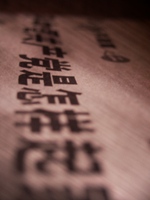Learn Mandarin Chinese
Progressive self study course for absolute beginners to intermediate learners

Progressive self study course for absolute beginners to intermediate learners

There are over 400 lessons to choose from. Absolute beginners should start at lesson 1. Each lesson continues where the last one left off.

Later lessons use the Chinese that was taught in earlier lessons. This way you are constantly reusing and remembering what was taught.

Premium subscribers get access to exercises, games and flashcard activities to reinforce what was taught.

Sign up with your Facebook account to try out the first 4 lessons of the course for free.

Most learners of Chinese try to take shortcuts and I was no exception. Learning to read and write Chinese seemed impossible for me to do in a short time, so at first I didn't bother. When I eventually did decide to tackle this area, I decided to focus on reading rather than writing. It was one thing for me to be able to recognize a complex character at a glance, but it was another thing for me to actually be able to reproduce it on paper with all its minute nuances. I later found that when learning to read Chinese, there are other shortcuts that I could take to make the learning process seem much quicker than it actually was.
In English, it is possible for learners to read a paragraph of text out aloud without having any clue as to what they are reading. For new words, whose pronunciation isn't known, it is still possible to try and come up with an approximation of what the word should sound like by phonetically sounding it out, which is usually enough for a native English to understand. In Chinese, this process is of course a lot trickier, since you frequently come across characters that are completely unrecognizable, with no phonetic clues to help you out. Whenever I was at this point, I was usually stumped. No amount of prodding or encouragement from a teacher was going to help me since there were no clues at all on how to proceed.
Well the truth is, there were clues, but they were just in different places. Most words in Chinese are formed from two or more characters, so usually when reading, knowing what one of the characters is, is enough to give you a clue as to what the word is or might be. For example, when looking at a menu, I would look for key characters. 肉 was a good one since by studying the characters around it, I was able to figure out what kind of meat was in the dish. I'd recognize 羊肉 as lamb since the 羊 resembled the horns on a sheep. Beef also featured similar characters. I found that by setting the context this way, I was much further ahead than having to sheepishly stare (pun intended) at the menu with no clue as to where to look. Similarly, I was able to spot 茶, so I knew I was dealing with tea. I also knew that 红 meant "red." So with that, I knew that I was dealing with a type of red tea. At the end of the day, it was much easier to ask the waiter "what kind of red tea is this?" than to simply ask "what's on this menu?"
Once you get your brain used to looking for clues in this way, you will find your brain automatically scanning texts for characters you know and figuring out the rest from context. I found myself being able to write tests in Chinese despite not being able to recognize many of the characters on the test paper. Here was a typical scenario:
I would see the following sentence: 冬天很冷,可是夏天很热。 At first glance, the only characters I could pick out were ...tiān hěn ..., kěshì ... tiān hěn ... My typical thought process was as follows:
"Hmm, I see two 天s there so we might be talking about days. Jīntian? Míngtiān? Zuótiān? No, I know those ones so it can't be days, so it must be seasons! There are two seasons there - "one is very... but the other is very..." The 冬 character there looks similar to 多. Duōtiān? That sounds similar to dōngtiān - winter?!? If that's winter, then perhaps 夏天 is summer. So perhaps we are talking about winter and summer. So winter is very... but summer is very... hot and cold?? I remember the character for hot looks a little like boiling water so that must be 热 which would make 冷 cold. I choose answer B: Winter is cold, but summer is hot. As long as the teacher wasn't deliberately trying to trick you, it was usually possible to determine the right answer this way.
This technique actually works quite well in Chinese because many vocabulary items tend to be grouped neatly. For example all the seasons end in 天, all transportation on land ends in 车, all meat ends in 肉 and so on. You don't even have to be perfect with it. For example if you looked at the characters for 年,车 and 牛 individually, it would be very easy to confuse them. But that usually isn't a problem since the characters are usually shown within some context. I would know that 牛肉 was beef since I was unlikely to see the 牛 mixed up with cars or dates.
Obviously the more characters you are able to recognize, the more accurate this technique becomes. Depending on how you look at it, the result of this and some of the listening techniques I've talked about previously is that you can either seem a lot smarter than you really are, or that you can learn a lot quicker than you originally thought.